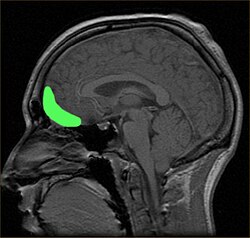Psychopathy
Psychopathy is a personality disorder or antisocial personality disorder. Psychopaths are unemotional. They do not show concern about the feelings or rights of others. They show almost no empathy, and do not try to follow norms. They don’t have a conscience and do not feel guilt. Another word for psychopathy is sociopathy.[1][2][3]
Many psychopaths are charming and often manage to work with other people. They use other people. Psychopaths often have other bad personality traits, like sadism, violence and deception. They are very selfish and get rid of people for whom they have no further use. They may have many children by many partners.[4]
The definition of psychopathy has changed. Different definitions are used. They only partly overlap and sometimes seem contradictory.[5]
There are efforts to use behaviour therapy to treat psychopaths; often, this may be done in prisons.
Some people are mislabeled as psychopaths, but have no problems with social norms, but they are good at influencing people. There is a difference between the sexes as to how psychopathy is shown. Men show it more as an antisocial pattern of behaviour. In women it shows more as a histrionic pattern (excessive attention-seeking).
Amongst professional psychiatrists, psychopathy is known for being difficult to treat.[6][7]
Psychopathy Media
Psychopathy is strongly correlated with crime, violence, and antisocial behavior.
From accidents such as the one of Phineas Gage, it is known that the prefrontal cortex plays an important role in moral behavior.
Dysfunction of the orbitofrontal cortex, among other areas, is implicated in the mechanism of psychopathy.
References
- ↑ Hare, Robert D. (1999). Without Conscience: the disturbing world of the psychopaths among us. New York: Guilford Press. ISBN 978-1-57230-451-2.
- ↑ Stone, Michael H.; Brucato, Gary (2019). The new evil: understanding the emergence of modern violent crime. Amherst, New York: Prometheus Books. pp. 48–52. ISBN 978-1633885325.
- ↑ Patrick, Christopher; Fowles, Don; & Krueger, Robert 2009. Triarchic conceptualization of psychopathy: Developmental origins of disinhibition, boldness, and meanness. Development and Psychopathology. Cambridge University Press. 21 (3): 913–938.
- ↑ Dutton, Kevin 2012. The Wisdom of Psychopaths. Scientific American / Farrar, Straus & Giroux. ISBN 978-0-374-70910-5 (e-book)
- ↑ Skeem J.L. et al 2011. (2011). "Psychopathic personality: bridging the gap between scientific evidence and public policy". Psychological Science in the Public Interest. 12 (3): 95–162. doi:10.1177/1529100611426706. PMID 26167886. S2CID 8521465.
- ↑ Vien, Anh; Beech, Anthony R. (1 July 2006). "Psychopathy: theory, measurement, and treatment". Trauma, Violence & Abuse. 7 (3): 155–174. doi:10.1177/1524838006288929. ISSN 1524-8380. PMID 16785285. S2CID 220339235.
- ↑ Dingfelder, Sadie F. (March 2004). "Treatment for the 'untreatable'". American Psychological Association. Archived from the original on 8 March 2016. Retrieved 12 March 2016.
Template:Psychopathy +{{{1}}}−{{{2}}}


